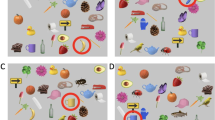Abstract
The present experiment examined the effect of having the D-stimuli as meaningful pictures when establishing 18 conditional discriminations and testing for the emergence of three 7-member equivalence classes (A→B→C→D→E→F→G). Twenty participants were randomly assigned to two main experimental groups. In one group, the participants were exposed to training and testing with abstract stimuli only (the ABS group). In the other group, the participants were exposed to D-stimuli as meaningful pictures and the A, B, C, E, F, and G stimuli as abstract stimuli (the PIC group). If the participants in the PIC group did not form equivalence classes, they repeated the experiment in a new condition (DA-as-PIC) that had a new stimulus set different from the PIC group where the D and A stimuli are meaningful stimuli whereas the B, C, E, F, and G stimuli were abstract stimuli. The participants who did not form equivalence classes in the DA-as-PIC condition repeated the experiment in a new condition (DAG-as-PIC) that had a new stimulus set different from the PIC and DA-as-PIC where the D, A, and G stimuli are meaningful stimuli whereas the B, C, E, and F stimuli were abstract. The main findings from the experiment showed that 1 of 10 participants in the ABS group formed equivalence classes, whereas 5 of 10 participants in the PIC group formed equivalence classes. Furthermore, the result showed that three of the five participants who did not form equivalence classes in the PIC group formed classes in the DA-as-PIC condition. Finally, two of the five participants who did not form equivalence classes in the DA-as-PIC condition formed classes in the DAG-as-PIC condition.






Similar content being viewed by others
Data Availability
The data for this study cannot be shared due to ethical reasons. Participants in the study did not consent to sharing their data with other persons outside the researchers who conducted the study.
References
Arntzen, E. (2004). Probability of equivalence formation: Familiar stimuli and training sequence. The Psychological Record, 54(2), 275–291. https://doi.org/10.1007/BF03395474.
Arntzen, E. (2012). Training and testing parameters in formation of stimulus equivalence: Methodological issues. European Journal of Behavior Analysis, 13(1), 123–135. https://doi.org/10.1080/15021149.2012.11434412.
Arntzen, E., Dechsling, A., & Fields, L. (2021). Expansion of arbitrary stimulus classes measured by sorting performances. Journal of the Experimental Analysis of Behavior, 115(1), 326–339.
Arntzen, E., & Eilertsen, J. M. (2020). using stimulus-equivalence technology to teach skills about nutritional content. Perspectives on Behavior Science, 43, 469–485. https://doi.org/10.1007/s40614-020-00250-2.
Arntzen, E., Granmo, S., & Fields, L. (2017). The relation between sorting tests and matching-to-sample tests in the formation of equivalence classes. The Psychological Record, 67(1), 81–96. https://doi.org/10.1007/s40732-016-0209-9.
Arntzen, E., Grondahl, T., & Eilifsen, C. (2010). The effects of different training structures in the establishment of conditional discriminations and subsequent performance on tests for stimulus equivalence. The Psychological Record, 60(3), 437–462. https://doi.org/10.1007/BF03395720.
Arntzen, E., & Hansen, S. (2011). Training structures and the formation of equivalence classes. European Journal of Behavior Analysis, 12(2), 483–503. https://doi.org/10.1080/15021149.2011.11434397.
Arntzen, E., & Holth, P. (1997). Probability of stimulus equivalence as a function of training design. The Psychological Record, 47(2), 309–320. https://doi.org/10.1007/BF03395227.
Arntzen, E., & Holth, P. (2000). Equivalence outcome in single subjects as a function of training structure. The Psychological Record, 50(4), 603–628. https://doi.org/10.1007/BF03395374.
Arntzen, E., & Lian, T. (2010). Trained and derived relations with pictures as nodes. The Psychological Record, 60(4), 659–677. https://doi.org/10.1007/BF03395738.
Arntzen, E., & Mensah, J. (2020). On the effectiveness of including meaningful pictures in the formation of equivalence classes. Journal of the Experimental Analysis of Behavior, 113(2), 305–321. https://doi.org/10.1002/jeab.579.
Arntzen, E., & Nartey, R. K. (2018). Equivalence class formation as a function of preliminary training with pictorial stimuli. Journal of the Experimental Analysis of Behavior, 110(2), 275–291. https://doi.org/10.1002/jeab.466.
Arntzen, E., Nartey, R. K., & Fields, L. (2014). Identity and delay functions of meaningful stimuli: enhanced equivalence class formation. The Psychological Record, 64(3), 349–360. https://doi.org/10.1007/s40732-014-0066-3.
Arntzen, E., Nartey, R. K., & Fields, L. (2015a). Enhanced equivalence class formation by the delay and relational functions of meaningful stimuli. Journal of the Experimental Analysis of Behavior, 103(3), 524–541. https://doi.org/10.1002/jeab.152.
Arntzen, E., Nartey, R. K., & Fields, L. (2018a). Graded delay, enhanced equivalence class formation, and meaning. The Psychological Record, 68(2), 123–140. https://doi.org/10.1007/s40732-018-0271-6.
Arntzen, E., Nartey, R. K., & Fields, L. (2018b). Reorganization of equivalence classes: Effects of preliminary training and meaningful stimuli. Journal of the Experimental Analysis of Behavior, 109(3), 564–5586. https://doi.org/10.1002/jeab.329.
Arntzen, E., Norbom, A., & Fields, L. (2015b). Sorting: An alternative measure of class formation? The Psychological Record, 65(4), 615–625. https://doi.org/10.1007/s40732-015-0132-5.
Bentall, R. P., Dickins, D. W., & Fox, S. R. A. (1993). Naming and equivalence: Response latencies for emergent relations. Quarterly Journal of Experimental Psychology, 46(2), 187–214. https://doi.org/10.1080/14640749308401085.
Buffington, D. M., Fields, L., & Adams, B. J. (1997). Enhancing equivalence class formation by pretraining of other equivalence classes. The Psychological Record, 47(1), 69–96. https://doi.org/10.1007/BF03395213.
Fields, L., Adams, B. J., & Verhave, T. (1993). The effects of equivalence class structure on test performaces. The Psychological Record, 43(4), 697–721. https://doi.org/10.1007/BF03395907.
Fields, L., Arntzen, E. & Doran, E. (2020). Yield as an essential measure of equivalence class formation, other measures, and new determinants. The Psychological Record, 70,175–186. https://doi.org/10.1007/s40732-020-00377-3.
Fields, L., Arntzen, E., & Moksness, M. (2014). Stimulus sorting: A quick and sensitive index of equivalence class formation. The Psychological Record, 64(3), 487–498. https://doi.org/10.1007/s40732-014-0034-y.
Fields, L., Arntzen, E., Nartey, R. K., & Eilifsen, C. (2012). Effects of a meaningful, a discriminative, and a meaningless stimulus on equivalence class formation. Journal of the Experimental Analysis of Behavior, 97(2), 163–181. https://doi.org/10.1901/jeab.2012.97-163.
Fields, L., Paone, D. (2020). Training modality and equivalence class formation under the simultaneous protocol: A test of stimulus control topography coherence theory. The Psychological Record 70, 293–305. https://doi.org/10.1007/s40732-020-00384-4.
Fields, L., Reeve, K., Rosen, D., Varelas, A., & Adams, B. (1997). Using the simultaneous protocol to study equivalence class formation: The facilitating effects of nodal number and size of previously established equivalence classes. Journal of the Experimental Analysis of Behavior, 67(3), 367–389. https://doi.org/10.1901/jeab.1997.67-367.
Fields, L., & Verhave, T. (1987). The structure of equivalence classes. Journal of the Experimental Analysis of Behavior, 48(2), 317–332. https://doi.org/10.1901/jeab.1987.48-317.
Holth, P., & Arntzen, E. (1998). Stimulus familiarity and the delayed emergence of stimulus equivalence or consistence nonequivalence. The Psychological Record, 48(1), 81–110. https://doi.org/10.1007/BF03395260.
Kennedy, C. H. (1991). Equivalence class formation influenced by the number of nodes separating stimuli. Behavioural Processes, 24, 219–245.
McIlvane, W. J., & Dube, W. V. (1992). Stimulus control shaping and stimulus control topographies. The Behavior Analyst, 15(1), 89–94. https://doi.org/10.1007/BF03392591.
Mensah, J., & Arntzen, E. (2017). Effects of meaningful stimuli contained in different numbers of classes on equivalence class formation. The Psychological Record, 67(3), 325–336. https://doi.org/10.1007/s40732-016-0215-y.
Nartey, R. K., Arntzen, E., & Fields, L. (2014). Two discriminative functions of meaningful stimuli that enhance equivalence class formation. The Psychological Record, 64(4), 777–789. https://doi.org/10.1007/s40732-014-0072-5.
Nartey, R. K., Arntzen, E., & Fields, L. (2015a). Enhancement of equivalence class formation by pretraining discriminative functions. Learning & Behavior, 43(1), 20–31. https://doi.org/10.3758/s13420-014-0158-6.
Nartey, R. K., Arntzen, E., & Fields, L. (2015b). Training order and structural location of meaningful stimuli: effects on equivalence class formation. Learning & Behavior, 43(4), 342–353. https://doi.org/10.3758/s13420-015-0183-0.
Nedelcu, R. I., Fields, L., & Arntzen, E. (2015). Arbitrary conditional discriminative functions of meaningful stimuli and enhanced equivalence class formation. Journal of the Experimental Analysis of Behavior, 103(2), 349–360. https://doi.org/10.1002/jeab.141.
Saunders, K. J., Saunders, R. R., Williams, D. C., & Spradlin, J. E. (1993). An interaction of instructions and training designs on stimulus class formation: Extending the analysis of equivalence. The Psychological Record, 43(4), 725–744. https://doi.org/10.1007/BF03395909.
Saunders, R. R., Chaney, L., & Marquis, J. G. (2005). Equivalence class establishment with two-, three-, and four-choice matching to sample by senior citizens. The Psychological Record, 55(4), 539–559. https://doi.org/10.1007/bf03395526.
Saunders, R. R., & Green, G. (1999). A discrimination analysis of training-structure effects on stimulus equivalence outcomes. Journal of the Experimental Analysis of Behavior, 72(1), 117–137. https://doi.org/10.1901/jeab.1999.72-117.
Sidman, M. (1994). Equivalence relations and behavior: A research story. Boston: Authors Cooperativ
Sidman, M., & Tailby, W. (1982). Conditional discrimination vs. matching to sample: an expansion of the testing paradigm. Journal of the Experimental Analysis of Behavior, 37(1), 5–22. https://doi.org/10.1901/jeab.1982.37-5.
Travis, R. W., Fields, L., & Arntzen, E. (2014). Discriminative functions and over-training as class-enhancing determinants of meaningful stimuli. Journal of the Experimental Analysis of Behavior, 102(1), 47–65. https://doi.org/10.1002/jeab.91.
Wulfert, E., Dougher, M. J., & Greenway, D. E. (1991). Protocol analysis of the correspondence of verbal behavior and equivalence class formation. Journal of the Experimental Analysis of Behavior, 56, 489–504. https://doi.org/10.1901/jeab.1991.56-489.
Funding
This research was funded by Oslo Metropolitan University.
Author information
Authors and Affiliations
Corresponding author
Ethics declarations
Conflict of Interest
The authors declare that there is no conflict of interest.
Ethical approval
All procedures performed in studies involving human participants were in accordance with the ethical standards and with the 1964 Helsinki Declaration and its later amendments or comparable ethical standards.
Informed consent
Informed consent was obtained from all individual participants included in the experiment.
Additional information
Publisher’s Note
Springer Nature remains neutral with regard to jurisdictional claims in published maps and institutional affiliations.
Rights and permissions
About this article
Cite this article
Mensah, J., Arntzen, E. The Role of Meaningful Stimuli in Large Stimulus Classes. Psychol Rec 72, 11–24 (2022). https://doi.org/10.1007/s40732-021-00483-w
Accepted:
Published:
Issue Date:
DOI: https://doi.org/10.1007/s40732-021-00483-w




